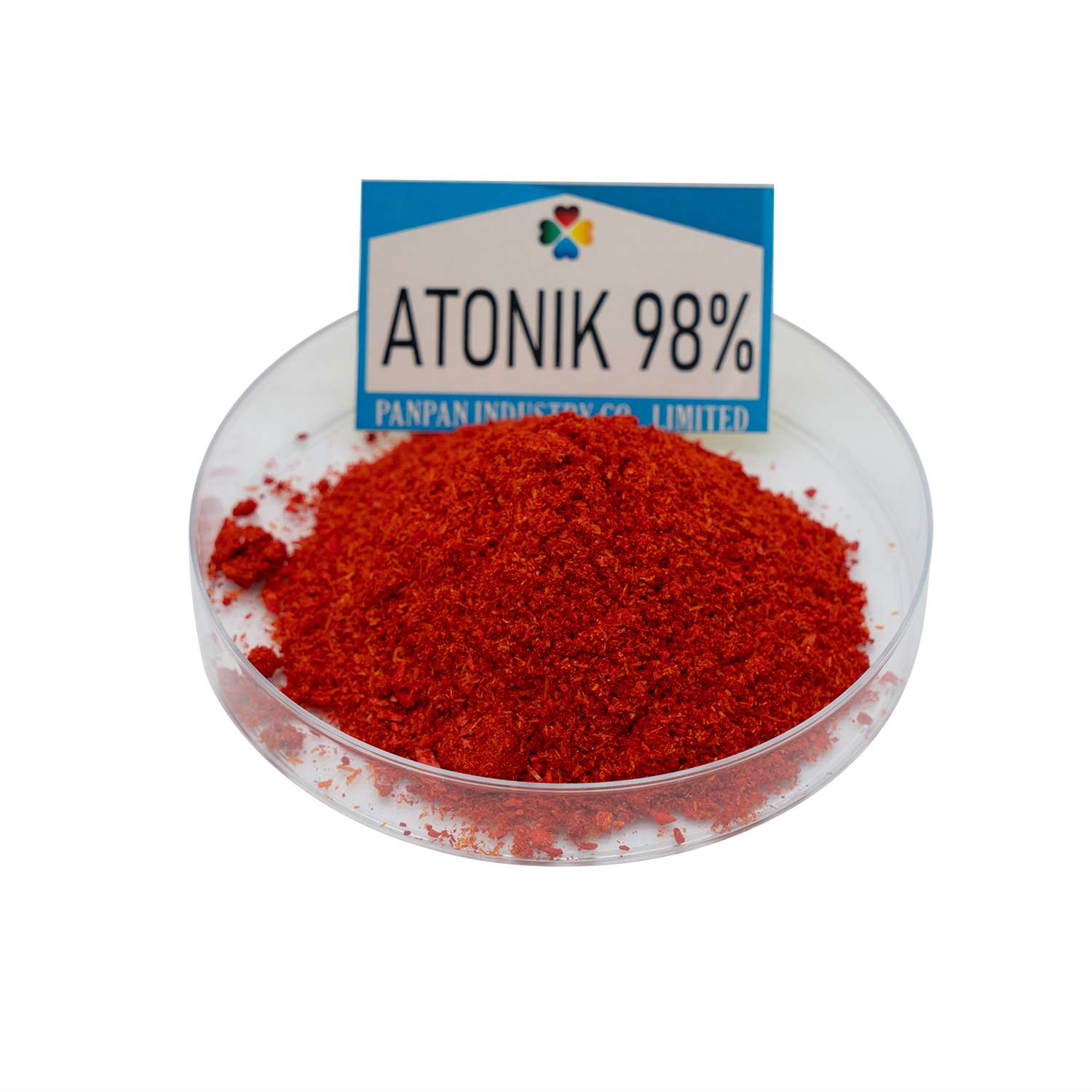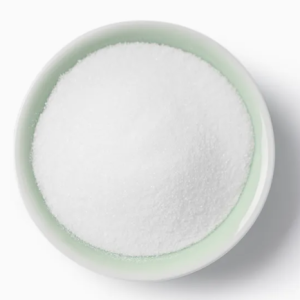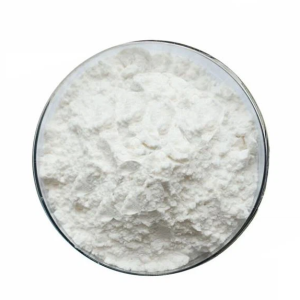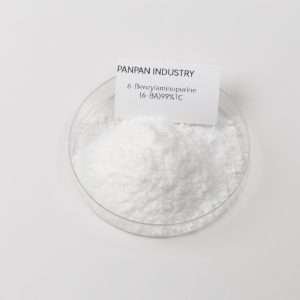Sodium Nitrophenolate Atonik
Sodium nitrophenolate can quickly penetrate into plants, promote intracellular protoplasmic flow, promote cell division and proliferation, facilitate the synthesis of chlorophyll and protein, break seed dormancy, promote germination and rooting, and promote flower bud formation, early flowering and fruit. Increase weight, prevent flowers and fruits from falling, increase crop yield, and improve the quality of agricultural products. Sodium nitrophenolate is a broad-spectrum plant regulator. It is suitable for rice, wheat, beans, corn and other food crops, rape, sesame and other oil crops, cotton, leafy vegetables, cruciferous vegetables, tomatoes, cucumbers, eggplants, etc. , watermelon, melon and other melons and fruits, citrus, apple, lychee, banana, longan, mango, pineapple and other fruits, can show excellent results.
Sodium Nitrophenolate (Potassium, Ammonium)
【1】Chinese common name Sodium nitrophenolate
【2】English common name sodium natrophenolate
【3】Commodity name Sodium Nitrophenolate
【4】Chemical name 5﹣Sodium nitroguaiacol, sodium o-nitrophenolate, sodium p-nitrophenolate
【5】CAS No. 5 – Sodium nitroguaiacol, 67233-85-6; Sodium o-nitrophenolate, 824-39-5; Sodium p-nitrophenolate, 824-78-2
【6】Molecular formula C7H6 NO4 Na , C6H4 NO3Na , C6H4 NO2Na
【7】Relative molecular mass 191.13, 161.09, 161.09
【8】Physical and chemical properties
Sodium nitrophenolate is a mixture of sodium 5-nitroguaiacol, sodium o-nitrophenolate and sodium p-nitrophenolate. The appearance is a mixture of red flake crystals, dark red needle crystals and yellow crystals. It is easily soluble. In water, soluble in ethanol, methanol, acetone and other organic solvents. It is stable at room temperature and has a phenolic aroma. Stable performance, can be mixed with general pesticides.
【9】Toxicity Low toxicity
【10】Main dosage forms
98% sodium nitrophenolate, 0.7%, 1.4%, 1.8% sodium nitrophenolate aqua, 1.4%, 1.8% ammonium nitrophenolate, 2% potassium nitrophenolate aqua
【11】Features
Sodium nitrophenolate can quickly penetrate into plants, promote intracellular protoplasmic flow, promote cell division and proliferation, facilitate the synthesis of chlorophyll and protein, break seed dormancy, promote germination and rooting, and promote flower bud formation, early flowering and fruit. Increase weight, prevent flowers and fruits from falling, increase crop yield, and improve the quality of agricultural products. Sodium nitrophenolate is a broad-spectrum plant regulator. It is suitable for rice, wheat, beans, corn and other food crops, rape, sesame and other oil crops, cotton, leafy vegetables, cruciferous vegetables, tomatoes, cucumbers, eggplants, etc. , watermelon, melon and other melons and fruits, citrus, apple, lychee, banana, longan, mango, pineapple and other fruits, can show excellent results.
【12】Applied technology
- Break the dormancy period
Barley, Wheat
Before sowing wheat seeds, use sodium nitrophenolate 6~12 mg/L, soak the seeds for 12 hours, and then dry them to half dry before sowing, which can break the seed dormancy, promote germination and rooting, and make the shoots thick and strong.
Rice
Before sowing, soak with sodium nitrophenolate 3~6 mg/L for 24~36 h, then remove and drain, and then germinate and sow.
Corn
Soaking the seeds with 3-6 mg/L sodium nitrophenolate for 12 hours can enhance the growth of maize plants, increase the 1000-kernel weight of maize, and improve the yield and quality of maize.
Soybean
Soaking seeds with 5-nitroguaiacol sodium 5 mg/L or sodium nitrophenolate 10 mg/L for 12 h can increase the bud weight, germination potential, germination rate and seed vigor of soybean.
Cucumber
Soaking seeds with 3~9 mg/L liquid medicine for 12 h can promote fast germination of seeds, developed root system, strong seedlings, and improve disease resistance.
Shrub
Sodium nitrophenolate 6 mg/L soaking shrub seeds for 12 hours can improve the germination potential of the shrub seeds, which can make the shrub seeds germinate as much as possible in a short period of time, and enhance the competitiveness of the shrub seeds themselves.
- Protect flowers and fruits, increase fruit weight
Tomato
Spraying with 6-9 mg/L sodium nitrophenolate solution at seedling stage, 7-15 days before flowering, fruit expansion stage and coloring stage can promote growth and development, early flowering, significantly improve fruit set rate, and effectively increase yield.
Cucumber
Spraying 3-6 mg/L sodium nitrophenolate solution at the young fruit stage, early flowering stage and young fruit stage can increase the number of female flowers, increase the rate of melon setting, reduce the rate of melonization, increase the yield significantly, and make the Cucumbers are harvested early, with straight strips, bright green color, sweet and refreshing taste, and improved product quality.
Bell peppers
Spraying 3 mg/L sodium nitrophenolate solution at the beginning and full blooming stage can significantly increase the number of colorful peppers, flowers and fruits, and fruit set.
Watermelon
Use 3 mg/L sodium nitrophenolate solution to spray once each at the seedling stage, the vine extension stage, the flowering stage and the fruiting stage (when the young melon is about 250g), to enhance the growth vigor of the melon seedlings, reduce the wilted diseased plants, and improve the growth of the melon. rate, single melon gained weight, increased yield, and increased sugar content.
Citrus
Spraying 2.3-2.8 mg/L sodium nitrophenolate 14 days after citrus withered flowers, and then spraying it every 7-10 days, and every 30 days after that, the fruit setting rate was increased by 28.67% compared with the control, and the effect was remarkable.
Apple
Spraying 6-9 mg/L sodium nitrophenolate solution once in 20 days before flowering, before flowering, young fruit stage and fruit expansion stage can promote yield increase and improve apple quality. The specific performance is that the nitrogen content in apple leaves is increased by 1.6%, the phosphorus content is increased by 0.3%~19.5%, and the amino acid content is increased by 0.9%~3.9%; various nutrients in the fruit are increased respectively: potassium 6.0%~66.5%, Calcium 5.0%~83.0%, phosphorus 2.2 times, protein 1.6 times, amino acids 41.4%~130.4% (among which aspartic acid increased 1.6~4.7 times, proline increased 1.5~3.2 times), vitamin C 5.8%~l1. 8%, and at the same time, the firmness of the fruit is greatly increased, and the storage period and supply and marketing period are prolonged.
Pear
Application of 20 mg/L sodium nitrophenolate at flowering stage increased fruit set rate by 6%-25.53%, yield increased by 18%-21.5%, single fruit weight increased by 15.69%, and soluble solids increased by 0.85%-1.1%.
Grape
When the grapes were sprayed with 6-9 mg/L sodium nitrophenolate 7d before and after flowering, the fruit setting rate could be increased by 78.97%. If 0.2% borax is added, the fruit setting rate can be increased by 80.9%; if 0.3% borax is added, the fruit setting rate can be increased by 84.69%.
Litchi
Spraying 6-9 mg/L sodium nitrophenolate solution before and after flowering can increase the content of soluble solids, increase the yield and improve the quality of litchi.
Mango
The 100 mg/L sodium nitrophenolate was sprayed once on the day of flowering, 7, 16, 27, 36, 45, and 56 days after flowering, and harvested on 76 days after flowering. The yield increased by 102.6% compared with the blank control.
Winter jujube
Use 6-12 mg/L sodium nitrophenolate solution to spray once each at flowering stage, young fruit stage, expansion stage and white ripe stage to improve fruit setting rate and yield.
Water bamboo
With sodium nitrophenolate 5.94 mg/L sprayed once 15~30d before the pregnant water jasmine, and sprayed once every 7 days, it can make the time of jasmine formation earlier by 4~5d, and the effective seedling number, The yield and yield of water bamboo were significantly improved.
- Promote vegetative growth of crops, increase growth rate, increase yield, and improve quality
Rice
4~5 days before seedling transplanting, at the booting stage and at the full heading stage, spraying a concentration of 3~4 mg/L, 50 kg per mu, can quickly restore the growth ability of rice. Improve uniformity and seed-setting rate, increase seeding activity by 1.9% to 2.7%, and increase production by 12% to 22%.
Barley, wheat
Spraying with 6-16 mg/L sodium nitrophenolate solution at seedling stage, jointing stage and grain filling stage can significantly increase thousand-grain weight, increase yield and improve quality.
Sorghum
Use 12-16 mg/L sodium nitrophenolate solution for foliar spraying before heading and during the flowering period, with an amount of 50 kg of liquid per mu each time, to increase yield and improve quality.
Corn
Spraying 30 mg/L sodium nitrophenolate solution once at the 7-9 leaf stage, from the big bell-mouth stage to the tasseling stage can increase the plant height, reduce the ear height, increase the rhizome diameter and the ear stem diameter. Increases the leaf area of stick clover, thereby increasing crop yield.
Soybean
Using 6-12 mg/L sodium nitrophenolate solution to spray once each at the flower bud formation stage, the early stage of pod formation and the bean pod expansion stage can increase the 100-grain weight of soybeans and increase the yield. Protein and crude fat content.
Green beans
Use 3 mg/L sodium nitrophenolate solution to spray at the seedling stage and the first flowering stage of green beans, 40~50 kg per mu, spray once every 7~19d, and spray 3~4 times in total, which is beneficial to the protection of green beans. Flowers and pods increase, and the harvesting period is 8-10 days earlier.
Eggplant
At the seedling stage, spraying 1.75-2.5 mg/L sodium nitrophenolate significantly promoted the plant height, stem diameter and leaf area of eggplant seedlings.
Agaricus bisporus
Adding 3 mg/L sodium nitrophenolate solution to the culture material can speed up the growth of mycelium, advance the fruiting time by 9 days, increase the yield by 22.39%, and increase the crude protein content in the fruiting bodies of agaricus bisporus.
Spinach
At the seedling stage, irrigating roots with 0.2 mg/L sodium nitrophenolate can promote the growth of spinach roots and increase the yield of spinach.
Ginger
Using 400g/mu of sodium nitrophenolate, ditching the ditch twice and applying chemical fertilizers during the sowing and soil cultivation of ginger, the plant height of ginger increased by 14.22%, the number of branches increased by 28.69%, and the yield increased by 18.53% compared with the control. Starch, soluble protein and amino acid content of ginger rhizomes.
Tea
In the early stage of spring tea, spraying 3-4.5 mg/L sodium nitrophenolate solution on the whole plant at the initial stage of 1 bud and 1 leaf can promote the early emergence of axillary buds, and the yield increase effect is obvious. Spring tea is generally sprayed about 2 times, summer and autumn tea can be combined with pest control and pesticides, evenly sprayed on the front and back of the leaves, and it is moderately wet but not flowing, to achieve two effects of pest control and growth promotion. According to the test, after spraying sodium nitrophenolate on tea trees, it showed a variety of physiological effects. First, the spacing between buds and leaves was elongated, and the bud weight increased. According to the measurement, the bud weight increased by 9.4% compared with the control. Germination, the germination density increased by 13.7%; the third is to increase the chlorophyll content, improve the photosynthesis ability, and the leaf color becomes greener.
Cotton
Spraying 3-6 mg/L sodium nitrophenolate solution once in the early stage, flowering stage and peach puffing stage can significantly improve the fruit setting rate and increase the yield. The test shows that the yield of seed cotton can be increased by 29.3%, and the yield of lint cotton can be increased by 20.2%.
Rape
Spraying 6-12 mg/L sodium nitrophenolate solution once in the greening stage, early flowering stage and final flowering stage can significantly increase the number of effective angles, increase the thousand-grain weight, and increase the yield.
Tobacco
The 3-6 mg/L sodium nitrophenolate solution was sprayed twice on the foliage of the whole plant at an interval of 10 d at the cluster stage, the yield was significantly increased, the proportion of high-quality tobacco was increased, and the output value was greatly increased.
Sugar cane
Spraying with 12-24 mg/L sodium nitrophenolate solution at the seedling stage, the split stage and the elongation stage can increase leaf separation, promote early maturity and increase yield, and increase sugar content.
Peanut
Using 6-12 mg/L sodium nitrophenolate solution to spray once on the 4th, 8th and 12th leaf stage of peanut main stem respectively, can make the leaf color dark green, reduce leaf spot disease, increase the number of results, and the pod and seed kernel are more abundant. In particular, the number of full fruits increases, the rate of full fruits is increased, and the effect of increasing yield is remarkable.
Beet
Spraying 12-16 mg/L sodium nitrophenolate solution twice in the growing period can increase the plant weight, root weight and sugar content of sugar beet.
Mushroom
The 9-16 mg/L sodium nitrophenolate solution was sprayed once at the turning tide period and the fruiting body formation period, and the yield increased significantly, and the harvest period of shiitake mushrooms was prolonged and the quality was improved.
Similar products of sodium nitrophenolate include potassium nitrophenolate and ammonium nitrophenolate. The difference between them and sodium nitrophenolate is that the ions connected to the hydroxyl group on the benzene ring are different, the physical properties are slightly different, and the chemical properties and biological activities are roughly the same. The application in agricultural production is roughly the same. Because the physical properties of sodium nitrophenolate are more stable, most of them use sodium nitrophenolate.
【13】Notes
①When the concentration is too high, it has inhibitory effect on crop buds and growth.
② It can be used in combination with pesticides and fertilizers, and the effect is better.
③ Stop using tobacco leaves 30 days before harvesting.
④ Store in a cool place.
Related products
FAQ
We are based in Henan, China, start from 2021,sell to South America(31.00%),North America(25.00%),Western Europe(15.00%),Central America(8.00%),Oceania(5.00%),Eastern Asia(5.00%),Eastern Europe(4.00%),Southeast Asia(3.00%),South Asia(2.00%),Africa(00.00%),Mid East(00.00%). There are total about 5-10 people in our office.
Always a pre-production sample before mass production;
Always final Inspection before shipment;
Gibberellin GA3,Cytokinin,Rooting Hormone,Fruit Coloring,Plant Growth Inhibitor
1. Professional supplier of Gibberellic acid,IBA, 6-Benzylaminopurine, CPPU,abscisic acid and other plant growth regulators 2. 12 years exporting experience with customers all over the world 3. Product has been approved by SGS
Accepted Delivery Terms: FOB,CFR,CIF,EXW,FAS,CIP,FCA,CPT,DEQ,DDP,DDU,Express Delivery,DAF,DES;
Accepted Payment Currency:USD,EUR,JPY,CAD,AUD,HKD,GBP,CNY,CHF;
Accepted Payment Type: L/C,D/P D/A,MoneyGram,Credit Card,PayPal,Western Union,Cash,Escrow;
Language Spoken:English,Chinese,Spanish






